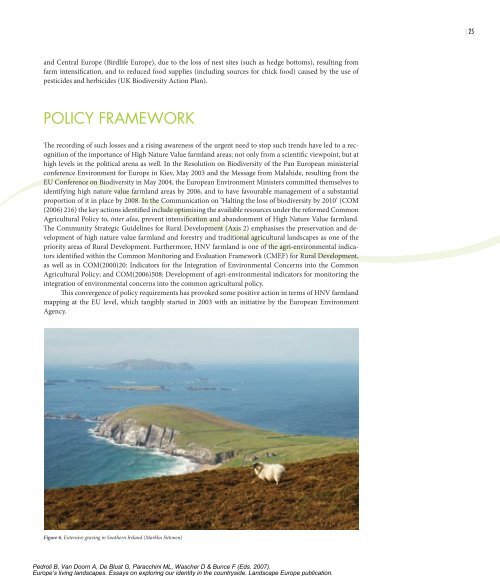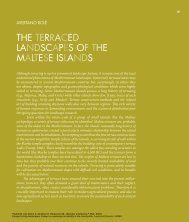high nature value farmland and traditional agricultural landscapes
high nature value farmland and traditional agricultural landscapes
high nature value farmland and traditional agricultural landscapes
Create successful ePaper yourself
Turn your PDF publications into a flip-book with our unique Google optimized e-Paper software.
<strong>and</strong> Central Europe (Birdlife Europe), due to the loss of nest sites (such as hedge bottoms), resulting from<br />
farm intensification, <strong>and</strong> to reduced food supplies (including sources for chick food) caused by the use of<br />
pesticides <strong>and</strong> herbicides (UK Biodiversity Action Plan).<br />
polIcy fraMework<br />
The recording of such losses <strong>and</strong> a rising awareness of the urgent need to stop such trends have led to a recognition<br />
of the importance of High Nature Value <strong>farml<strong>and</strong></strong> areas; not only from a scientific viewpoint, but at<br />
<strong>high</strong> levels in the political arena as well. In the Resolution on Biodiversity of the Pan European ministerial<br />
conference Environment for Europe in Kiev, May 2003 <strong>and</strong> the Message from Malahide, resulting from the<br />
EU Conference on Biodiversity in May 2004, the European Environment Ministers committed themselves to<br />
identifying <strong>high</strong> <strong>nature</strong> <strong>value</strong> <strong>farml<strong>and</strong></strong> areas by 2006, <strong>and</strong> to have favourable management of a substantial<br />
proportion of it in place by 2008. In the Communication on ‘Halting the loss of biodiversity by 2010’ (COM<br />
(2006) 216) the key actions identified include optimising the available resources under the reformed Common<br />
Agricultural Policy to, inter alea, prevent intensification <strong>and</strong> ab<strong>and</strong>onment of High Nature Value <strong>farml<strong>and</strong></strong>.<br />
The Community Strategic Guidelines for Rural Development (Axis 2) emphasises the preservation <strong>and</strong> development<br />
of <strong>high</strong> <strong>nature</strong> <strong>value</strong> <strong>farml<strong>and</strong></strong> <strong>and</strong> forestry <strong>and</strong> <strong>traditional</strong> <strong>agricultural</strong> l<strong>and</strong>scapes as one of the<br />
priority areas of Rural Development. Furthermore, HNV <strong>farml<strong>and</strong></strong> is one of the agri-environmental indicators<br />
identified within the Common Monitoring <strong>and</strong> Evaluation Framework (CMEF) for Rural Development,<br />
as well as in COM(2000)20: Indicators for the Integration of Environmental Concerns into the Common<br />
Agricultural Policy; <strong>and</strong> COM(2006)508: Development of agri-environmental indicators for monitoring the<br />
integration of environmental concerns into the common <strong>agricultural</strong> policy.<br />
This convergence of policy requirements has provoked some positive action in terms of HNV <strong>farml<strong>and</strong></strong><br />
mapping at the EU level, which tangibly started in 2003 with an initiative by the European Environment<br />
Agency.<br />
Figure 6. Extensive grazing in Southern Irel<strong>and</strong> (Markku Siitonen)<br />
Pedroli B, Van Doorn A, De Blust G, Paracchini ML, Wascher D & Bunce F (Eds. 2007).<br />
Europe’s living l<strong>and</strong>scapes. Essays on exploring our identity in the countryside. L<strong>and</strong>scape Europe publication.<br />
| 25




